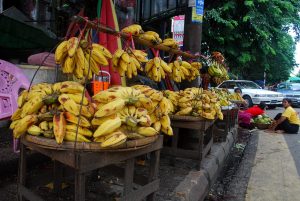By Sebastian Strangio

Northern Myanmar’s Kachin State is in the midst of a boom in commercial banana cultivation driven by cross-border investment from China, according to a new report. The report from Mekong Region Land Governance (MRLG), published on November 30, outlines the recent rapid expansion of tissue-culture banana plantations in the state, intended almost entirely for export to the Chinese market.
According to the MRLG report, the volume of bananas exported to China has jumped from less than 100,000 tons in 2015-16 to 733,949 tons in 2019-20, according to Myanmar government export data. As of 2019, the report states, banana plantations covered an estimated 170,000 hectares across Kachin State.
“With strong demand from China, the presence of cheap land and labor, fertile soils, favorable climatic conditions, and a proximity to Yunnan Province,” the MRLG report states, “the high potential net return of banana over a short period of time explains the rapid expansion of the crop and the related rush to acquire land.”
Most of the plantations operate on a model in which agricultural inputs, financing, and some labor are sent from China, with land and further labor sourced from within Myanmar. The harvested fruit is then trucked over the border and sold on the Chinese market. Tissue culture is a technology that allows the for the rapid mass reproduction of banana plants, producing a high degree of uniformity well suited for commercial cultivation.
Most interestingly, these plantations span the lines of conflict in Kachin State, existing both in areas run by the government and those under the control of militias and ethnic armed groups such as the Kachin Independence Organization (KIO), which controls a sliver of territory running along the Chinese border.
To open up more land to cultivation, the report details how Chinese investors – both large enterprises and small-scale investors – have established an intricate mesh of connections with local business networks. These include figures from the Kachin State government, the military, various militia groups, and the KIO.
This rapid expansion of banana cultivation in Kachin State has come at a cost. The report states that the intensive use of chemical fertilizers and pesticides on the plantations has led to major environmental and health impacts. “Soil degradation and erosion can occur even after three years,” it states, “leaving the land unusable for several years afterwards. Chemical run off is entering water sources, affecting the health of humans, livestock and local biodiversity.”
The expansion of these mega-plantations is also compounding land conflicts in the region. While some local smallholders have benefited from renting their land to Chinese investors for banana cultivation, these agreements are frequently “obtained through coercion,” involving pressure from community leaders, or the provision of misleading information. Many smallholders have lost their land altogether without consultation, particularly in cases of land left empty by people displaced by conflict.
Monoculture plantations are one of the most striking signs of China’s expanding economic presence in the hilly regions of mainland Southeast Asia bordering Yunnan province. Many have their origins in the Opium Replacement Special Fund created by China’s State Council in 2006, which offered financial incentives to Chinese businesses to engage in private agribusiness schemes in northern Myanmar and Laos.
The growth of banana cultivation in Kachin State mirrors the situation in neighboring Laos, which has seen a similar spike in monoculture plantations across its northern provinces, mostly of bananas, but also including watermelons, corn, and cassava.
Banana cultivation in Laos leapt upwards in 2012, when Beijing cut off tropical fruit imports from the Philippines to punish it for the standoff over Scarborough Shoal in the South China Sea. After reports that workers were being poisoned by the use of powerful pesticides, the government declared a ban on new plantations in 2017, although questions remain about how effectively it has been enforced.
The MRLG report highlights the difficulty of addressing some of the negative impacts of Chinese investments in areas of mainland Southeast Asia that have long eluded central state control. It also highlights the complex ways in which outside capital, whether from China or elsewhere, interacts with – and magnifies – existing inequities. “Banana production is not a new, isolated phenomenon,” the report states, “but has emerged out of existing structures of power, conflict, and trade.”
No comments:
Post a Comment